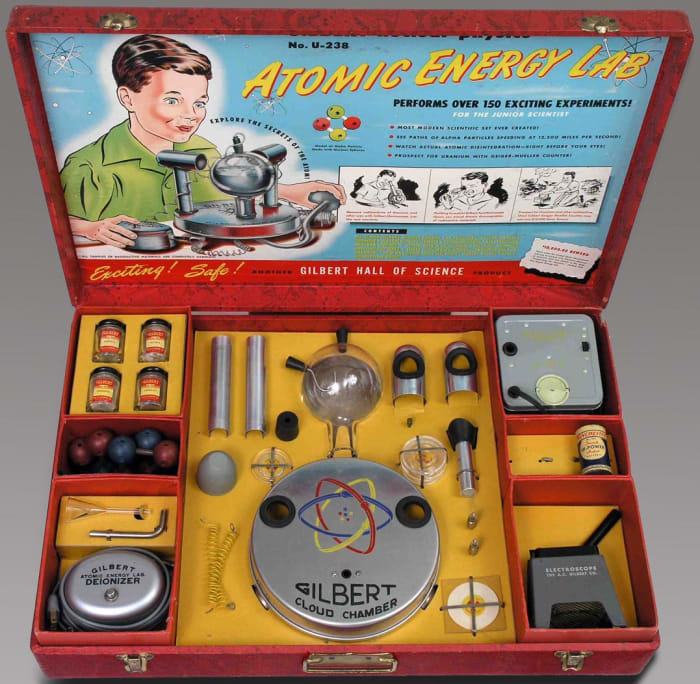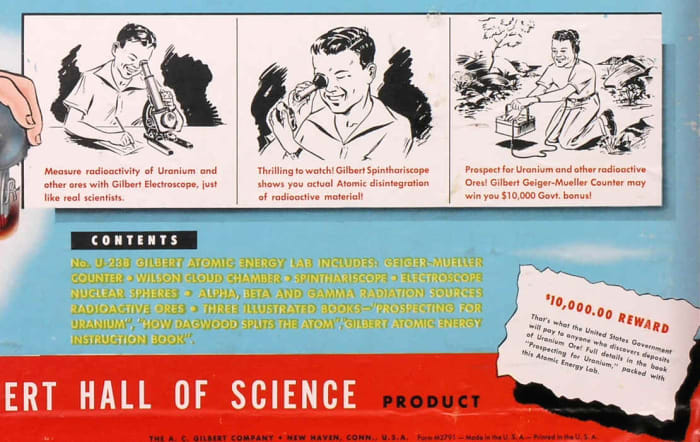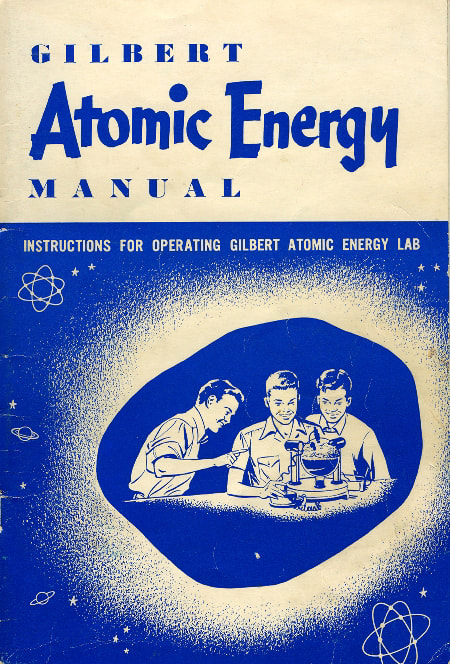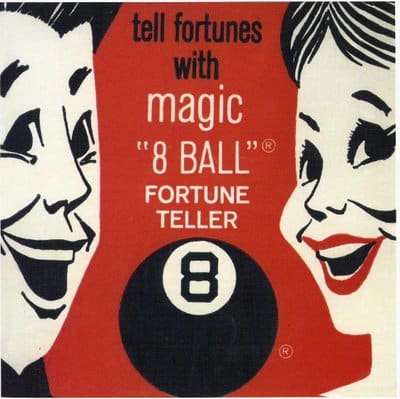Hey kids! Who wants to have fun with uranium?
If you were a child in The Fifties, your hand shot up like a Soviet Union R-7 ICBM rocket. You know, the fiery beast that in 1957 launched not only Sputnik, the first satellite to orbit the Earth, but also launched the fears of a nation. Our nation. The U.S of A.
So a little uranium among friends? Sure, why not?
Amidst the chill of the Cold War, science mattered. Today? Not so much. In The Fifties there was less debate. People in white lab coats were respected because, well, they wore white lab coats and you didn’t.
Back then, the ability to successfully blast a satellite into space was a Big Deal. It meant the Russians were strong, forward thinkers and certainly about to crush us. By comparison, Americans were weak, lazy and – sure enough – our national pants zipper was open.
If something wasn’t done fast, we’d be eating borscht for dinner.

Forget the threat of shooting your eye out with the Red Ryder BB Gun, the REAL Most Dangerous Toy Ever is the U-238 Atomic Energy Lab from A.C. Gilbert Co.
Image courtesy of Oak Ridge Associated Universities
Fortunately, a seed of science was planted in the fertile minds of children early in The Fifties that would blossom in The Sixties and forever change the course of global history. Which is why we order hamburgers today at the drive-up and not beet soup .
Thank you A.C. Gilbert Co. and your nifty little contribution to playtime fun: The U-238 Atomic Energy Lab, only The Most Dangerous Toy Ever.

Fortunately for Mom and Dad, The Atomic Energy Lab stressed the peace-time role of atomic energy. There wasn’t a hint of the A-bomb in the whole kit.
When The Atomic Energy Lab hit the market in 1950, promising more than 150 “exciting experiments” for the junior scientist, it was one of the most elaborate science kits available. In addition to four small jars of actual uranium, it had beta-alpha, beta, and gamma radiation sources. It contained a cloud chamber, a spinthariscope (a device for watching atoms decay – FUN!), an electroscope, and a Geiger counter to see if your dog, Spot, was sneaking radioactive scraps from your lab behind your back, the scamp.
The lab, which sold for $49.50, also included a 60-page instruction book and a guide to mining uranium. But wait, there’s more.
The kit boasts a handy manual on how to split atoms. I know what you’re thinking: Gosh, that sounds dangerous. Well, don’t worry Mom and Dad, the manual features the classic comic book couple Blondie and Dagwood Bumstead, as well as their children, dog and friends, who all explain the basics of atomic energy. So you know it’s safe.
In the manual dressed up as a comic book, Blondie, Dagwood and the entire gang shrink to the size of atoms while Mandrake the Magician (!), yet another popular comic strip hero of the day, supervises the proceedings, explaining how to split an atom of uranium-235.

Although it sold for about $50 back in 1950, today The Atomic Energy Lab, which included this handy manual, can sell for as much as $5,000 today.
Maybe that’s what we’re doing wrong today, and why so many people seem to struggle with science. We simply need more comic strip characters explaining the basics. I’m sure if Snoopy were heading up the Office of Science a lot more people would embrace it. But I digress.
The A.C. Gilbert Co. had a history of making science “fun”. The company made chemistry sets, American Flyer toy trains and, among other wonders, the Erector Set, a metal nuts and bolts construction set that promised kids the opportunity to build their own toys. Mostly the nuts and bolts got lost under the sofa, only to be sucked up when Mom vacuumed, but still …
Even so, the Atomic Energy Lab was no laughing matter. That’s why the A.C. Gilbert Co. included this warning to kids: “Users should not take ore samples out of their jars, for they tend to flake and crumble and you would run the risk of having radioactive ore spread out in your laboratory.”
And no one wants that. Forget the health risks, kids, the problem with removing radioactive ore from a jar and getting it all over the kitchen table is that doing so would raise the background radiation, thus invalidating your experimental results. Messy has no place in science.
Of course, kids are messy. Besides, The Fifties toy-scape also included far-less-scientific fun like the Pogo Stick, Hula Hoop, Play-Doh, Silly Putty and the Magic 8-ball. The future of The Atomic Energy Lab? “Outlook not so good,” the Magic 8-ball would have replied if anyone had bothered to ask.
Fewer than 5,000 Atomic Energy Labs were sold before being pulled from the market in 1951.
Today we may be perplexed that a toy containing radioactive elements ever made it onto the market. But at the time, radioactivity wasn’t considered dangerous. Why should parents worry? After all, the inside cover of The Atomic Energy Lab assured the product “Safe!”
Alas, the 1966 Child Protection Act, banning the sale of toys that contained hazardous substances, disagreed. Kids would never again find uranium-themed toys under the Christmas tree.
No matter. Those science nerds who somehow survived childhood radioactive fallout from The Atomic Energy Lab became the leaders of our Scientific Community in The Sixties, a decade that witnessed the first human heart transplant, the first laser and, of course, the first Man on The Moon.
So thanks again, Atomic Energy Lab, The Most Dangerous Toy Ever. Today we bask in the glow of your enthusiasm for science. And if I can get my Atomic Energy Lab Geiger counter to work, I should be able to tell if that glow is radioactive.
You May Also Like:
Ten Most Valuable Hot Wheels Cars










